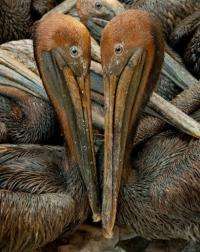Oiled birds everywhere, but little rescue crews can do

Michael Seymour peers at the oiled pelican floating near an island of mangrove trees and winces in frustration because -- once again -- there's absolutely nothing he can do to help.
An amber sheen has stained the pelican's white head and brown chest and wings. But the oil isn't thick enough to keep it from flying away if Seymour approaches.
"The only way to catch a bird in that condition is to chase it repeatedly until it gets tired," says Seymour, an ornithologist with the Louisiana Department of Wildlife and Fisheries.
"We're just going to be putting him under more stress than we need to."
Oiled birds aren't hard to find some 54 days after an explosion on the BP-leased Deepwater Horizon drilling rig sparked the worst environmental catastrophe in US history.
The problem is finding a bird that can be rescued without doing more harm than good, Seymour says.
He's seen eggs crushed by well-meaning amateurs who trampled through a pelican colony to capture a single oiled bird.
Even stepping onto a rocky shore can send hundreds of panicked nesting birds into the skies, exposing their fledglings and eggs to the sweltering sun.
Taking an oiled chick away from its parents means it may never learn the skills it needs to survive on its own.
And capturing a lightly oiled bird still able to fly and feed itself could mean leaving its chicks or eggs untended.
"It's a tough decision to make, but sometimes we have to make hard decisions for the greater good of the birds," Seymour says as he directs the boat captain to move on to another island and leave the oiled pelican behind.
Sometimes they can't help but take a risk, like with a baby pelican that had fallen out of its nest into a puddle of oil. But, too often, Seymour has to simply watch the birds preen and hope that they can clean themselves.
Further complicating the rescue efforts is the very topography which makes Louisiana's coastal wetlands such prime nesting grounds.
It can take 30 minutes to walk ten feet through the tangled, sunken mangrove roots where there's plenty of places for the frightened birds to hide. There's nothing to stand on at all in many of the bayous. And the shifting tides can push the oil deep into the marshes.
Most of Louisiana's oiled birds are captured only if their feathers are so sticky they can't fly and if they can be plucked off the water or a solid shore.
The work will be easier for rescue crews working along the rock or sandy beaches of Mississippi, Alabama and Florida. But with the slick spreading across such a vast region, most badly oiled birds will likely die before they can be rescued, if they're found at all.
Some 530 oiled birds have been captured in time to be treated and hopefully released back into the wild. Another 725 bird carcasses have collected for evidence.
Oil is still gushing out of the ruptured well some 52 miles offshore and far below the surface.
"It sure would be nice to have that well capped," Seymour tells AFP Sunday. "We don't know when this is going to end and we know the oil is going to keep coming in waves."
The biggest concern in Louisiana is the threat to species which were already on the brink, like the brown pelicans and reddish egrets, Seymour says.
The brown pelican -- Louisiana's state bird -- was nearly wiped in the 1970's due to contamination from the pesticide DDT.
Careful management, and a ban on DDT, allowed the pelicans to thrive to the point where they were taken off the endangered species last November.
Now, it faces the double threat of oil and chemical dispersants in the water and contamination from the fish that are swimming in it.
There are only about 100 reddish egrets breeding pairs left in the state, Seymour says. And a thick ribbon of oil has slipped past the protective boom to coat an island near Grand Isle where a dozen of those pairs are nesting.
"You can't afford to lose any of those birds," he tells AFP.
(c) 2010 AFP




















